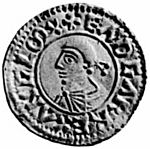Penny (English coin) facts for kids
  |
|
| A silver 'Reform' penny from the time of King Edgar I, made in Norwich around 973–975. |
The English penny (plural "pence") is a very old coin that has been used in England for over a thousand years! It was first made around 785 AD by King Offa of Mercia. These early pennies were small silver coins, weighing about 1.3 to 1.5 grams. They were similar to other coins called deniers used in Europe back then.
For a long time, the penny was the main coin in England. It was made of silver and was worth a small part of a pound sterling. Pennies were used continuously until the Kingdom of Great Britain was formed in 1707.
Contents
What's in a Name?
The word "penny" comes from an old English word, pennige. It's related to the German word Pfennig. You might have seen "d." used as an abbreviation for penny, like "12d." for twelve pence. This "d." comes from the Roman word denarius, which was another ancient coin. People used "d." for pennies until 1971, when British money changed to a decimal system.
Penny Sayings
Because pennies were so common and worth a small amount, many sayings and idioms use the word "penny." These phrases often talk about how common or how little something is worth. Here are some examples:
- cut (one) off without a penny: To leave someone with no money at all.
- not have two pennies to rub together: To be very poor.
- penny-pincher: Someone who is very careful with money and doesn't like to spend it.
- penny-wise and pound-foolish: Being careful with small amounts of money but wasteful with large amounts.
- spend a penny: A polite way to say you need to use the toilet.
- worth every penny: Something that is definitely worth the money you paid for it.
A Brief History of the Penny
The history of the English penny is quite fascinating!
Early Silver Pennies
In Anglo-Saxon England, silver pennies were used to pay the Danegeld. This was like "protection money" paid to the Vikings to stop them from attacking the land. It was a huge burden! For example, more Anglo-Saxon pennies from that time have been found in Denmark than in England. This shows how much money was paid to the Vikings.
During the time of King Ethelred the Unready (978–1016), about 40 million pennies were paid to the Danes. Later, King Canute (1016–1035) paid his army another 20 million pennies. That's a lot of silver!
How Pennies Changed Over Time
When pennies were first made, they weighed about 1.3 to 1.5 grams. Later, their weight was made standard. The type of silver used was also very important. In 1158, under King Henry II, pennies were made from "sterling silver," which is 92.5% pure silver.
Because the purity and weight of the coin were so important, the name of the person who made the coin (the moneyer) and the place where it was made (the mint) were often put on the back of the coin.
For about 500 years, the penny was the only coin made in England! It wasn't until 1257 that King Henry III tried to make a gold coin. Later, smaller coins like halfpennies and farthings, and larger coins like the groat, were also introduced.
By 1702, the amount of silver in British coins was set. Sixty-two pennies were supposed to contain one troy ounce of sterling silver. This standard was used for a long time, from 1601 to 1816.
Want to Learn More?
The penny has a long and detailed history! You can learn more about it in different periods:
- History of the English penny (c. 600-1066) (From early times to the Norman Conquest)
- History of the English penny (1066-1154) (The early Norman kings)
- History of the English penny (1154-1485) (The Plantagenet kings)
- History of the English penny (1485-1603) (The Tudor period)
- History of the English penny (1603–1707) (The Stuart kings and the Commonwealth)
- History of the British penny (1714-1901) (The Hanoverian kings)
- History of the British penny (1901-1970) (The 20th century penny)
- Decimal Day, 1971 (When British money changed)
- Penny (British decimal coin) (Pennies used from 1971 until today)
See also

